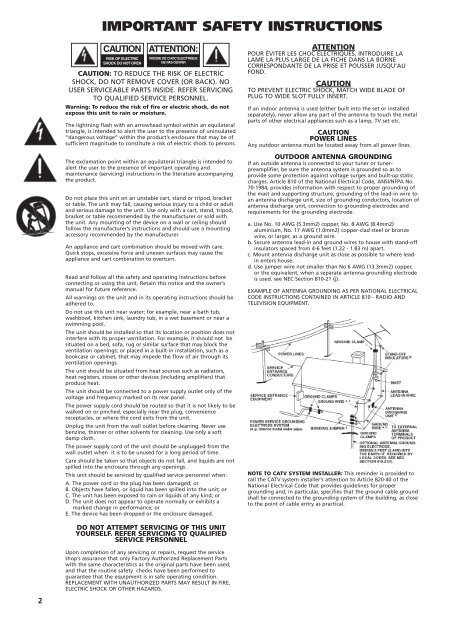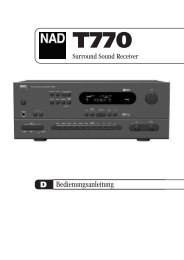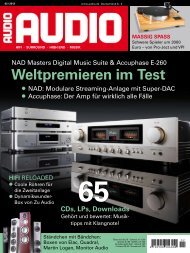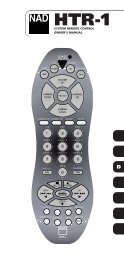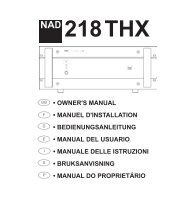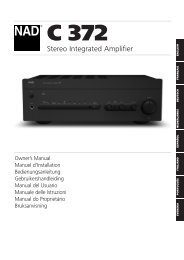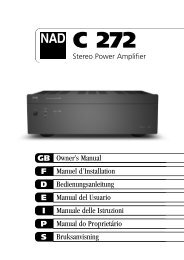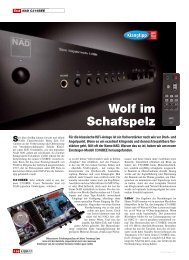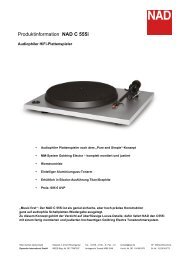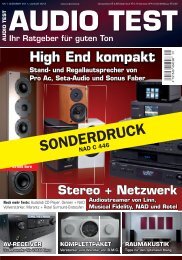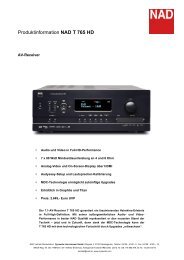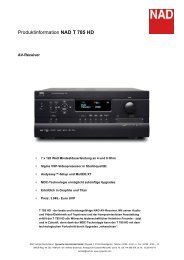C350 manual - NAD
C350 manual - NAD
C350 manual - NAD
Create successful ePaper yourself
Turn your PDF publications into a flip-book with our unique Google optimized e-Paper software.
2<br />
IMPORTANT SAFETY INSTRUCTIONS<br />
CAUTION<br />
RISK OF ELECTRIC<br />
SHOCK DO NOT OPEN<br />
ATTENTION:<br />
RISQUE DE CHOC ELECTRIQUE<br />
NE PAS OUVRIR<br />
CAUTION: TO REDUCE THE RISK OF ELECTRIC<br />
SHOCK, DO NOT REMOVE COVER (OR BACK). NO<br />
USER SERVICEABLE PARTS INSIDE. REFER SERVICING<br />
TO QUALIFIED SERVICE PERSONNEL.<br />
Warning: To reduce the risk of fire or electric shock, do not<br />
expose this unit to rain or moisture.<br />
The lightning flash with an arrowhead symbol within an equilateral<br />
triangle, is intended to alert the user to the presence of uninsulated<br />
“dangerous voltage” within the product’s enclosure that may be of<br />
sufficient magnitude to constitute a risk of electric shock to persons.<br />
The exclamation point within an equilateral triangle is intended to<br />
alert the user to the presence of important operating and<br />
maintenance (servicing) instructions in the literature accompanying<br />
the product.<br />
Do not place this unit on an unstable cart, stand or tripod, bracket<br />
or table. The unit may fall, causing serious injury to a child or adult<br />
and serious damage to the unit. Use only with a cart, stand, tripod,<br />
bracket or table recommended by the manufacturer or sold with<br />
the unit. Any mounting of the device on a wall or ceiling should<br />
follow the manufacturer’s instructions and should use a mounting<br />
accessory recommended by the manufacturer.<br />
An appliance and cart combination should be moved with care.<br />
Quick stops, excessive force and uneven surfaces may cause the<br />
appliance and cart combination to overturn.<br />
Read and follow all the safety and operating instructions before<br />
connecting or using this unit. Retain this notice and the owner’s<br />
<strong>manual</strong> for future reference.<br />
All warnings on the unit and in its operating instructions should be<br />
adhered to.<br />
Do not use this unit near water; for example, near a bath tub,<br />
washbowl, kitchen sink, laundry tub, in a wet basement or near a<br />
swimming pool.<br />
The unit should be installed so that its location or position does not<br />
interfere with its proper ventilation. For example, it should not be<br />
situated on a bed, sofa, rug or similar surface that may block the<br />
ventilation openings; or placed in a built-in installation, such as a<br />
bookcase or cabinet, that may impede the flow of air through its<br />
ventilation openings.<br />
The unit should be situated from heat sources such as radiators,<br />
heat registers, stoves or other devices (including amplifiers) that<br />
produce heat.<br />
The unit should be connected to a power supply outlet only of the<br />
voltage and frequency marked on its rear panel.<br />
The power supply cord should be routed so that it is not likely to be<br />
walked on or pinched, especially near the plug, convenience<br />
receptacles, or where the cord exits from the unit.<br />
Unplug the unit from the wall outlet before cleaning. Never use<br />
benzine, thinner or other solvents for cleaning. Use only a soft<br />
damp cloth.<br />
The power supply cord of the unit should be unplugged from the<br />
wall outlet when it is to be unused for a long period of time.<br />
Care should be taken so that objects do not fall, and liquids are not<br />
spilled into the enclosure through any openings.<br />
This unit should be serviced by qualified service personnel when:<br />
A. The power cord or the plug has been damaged; or<br />
B. Objects have fallen, or liquid has been spilled into the unit; or<br />
C. The unit has been exposed to rain or liquids of any kind; or<br />
D. The unit does not appear to operate normally or exhibits a<br />
marked change in performance; or<br />
E. The device has been dropped or the enclosure damaged.<br />
DO NOT ATTEMPT SERVICING OF THIS UNIT<br />
YOURSELF. REFER SERVICING TO QUALIFIED<br />
SERVICE PERSONNEL<br />
Upon completion of any servicing or repairs, request the service<br />
shop’s assurance that only Factory Authorized Replacement Parts<br />
with the same characteristics as the original parts have been used,<br />
and that the routine safety checks have been performed to<br />
guarantee that the equipment is in safe operating condition.<br />
REPLACEMENT WITH UNAUTHORIZED PARTS MAY RESULT IN FIRE,<br />
ELECTRIC SHOCK OR OTHER HAZARDS.<br />
ATTENTION<br />
POUR ÉVITER LES CHOC ELECTRIQUES, INTRODUIRE LA<br />
LAME LA PLUS LARGE DE LA FICHE DANS LA BORNE<br />
CORRESPONDANTE DE LA PRISE ET POUSSER JUSQU’AU<br />
FOND.<br />
CAUTION<br />
TO PREVENT ELECTRIC SHOCK, MATCH WIDE BLADE OF<br />
PLUG TO WIDE SLOT FULLY INSERT.<br />
If an indoor antenna is used (either built into the set or installed<br />
separately), never allow any part of the antenna to touch the metal<br />
parts of other electrical appliances such as a lamp, TV set etc.<br />
CAUTION<br />
POWER LINES<br />
Any outdoor antenna must be located away from all power lines.<br />
OUTDOOR ANTENNA GROUNDING<br />
If an outside antenna is connected to your tuner or tunerpreamplifier,<br />
be sure the antenna system is grounded so as to<br />
provide some protection against voltage surges and built-up static<br />
charges. Article 810 of the National Electrical Code, ANSI/NFPA No.<br />
70-1984, provides information with respect to proper grounding of<br />
the mast and supporting structure, grounding of the lead-in wire to<br />
an antenna discharge unit, size of grounding conductors, location of<br />
antenna discharge unit, connection to grounding electrodes and<br />
requirements for the grounding electrode.<br />
a. Use No. 10 AWG (5.3mm2) copper, No. 8 AWG (8.4mm2)<br />
aluminium, No. 17 AWG (1.0mm2) copper-clad steel or bronze<br />
wire, or larger, as a ground wire.<br />
b. Secure antenna lead-in and ground wires to house with stand-off<br />
insulators spaced from 4-6 feet (1.22 - 1.83 m) apart.<br />
c. Mount antenna discharge unit as close as possible to where leadin<br />
enters house.<br />
d. Use jumper wire not smaller than No.6 AWG (13.3mm2) copper,<br />
or the equivalent, when a separate antenna-grounding electrode<br />
is used. see NEC Section 810-21 (j).<br />
EXAMPLE OF ANTENNA GROUNDING AS PER NATIONAL ELECTRICAL<br />
CODE INSTRUCTIONS CONTAINED IN ARTICLE 810 - RADIO AND<br />
TELEVISION EQUIPMENT.<br />
NOTE TO CATV SYSTEM INSTALLER: This reminder is provided to<br />
call the CATV system installer’s attention to Article 820-40 of the<br />
National Electrical Code that provides guidelines for proper<br />
grounding and, in particular, specifies that the ground cable ground<br />
shall be connected to the grounding system of the building, as close<br />
to the point of cable entry as practical.


